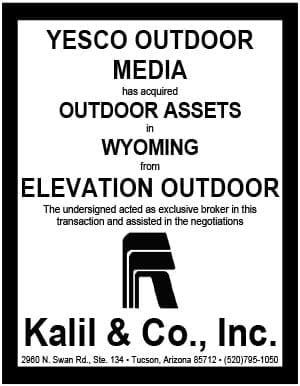 Out of home company sales occur at a multiple of Billboard Cashflow. Reader Leonard Busby of Busby Outdoor asked Insider to define Billboard Cashflow and explain how it differs from Cashflow (EBIDTA)
Out of home company sales occur at a multiple of Billboard Cashflow. Reader Leonard Busby of Busby Outdoor asked Insider to define Billboard Cashflow and explain how it differs from Cashflow (EBIDTA)
Billboard Cashflow is out of home company Revenue (space rental plus install/production income) less certain direct expenses:
- lease costs
- sales expense
- utilities
- property taxes
- recurring permit fees
- recurring maintenance and repairs.
Billboard Cashflow is much higher than Cashflow (EBIDTA) because it leaves out the following:
- corporate overhead
- insurance
- office rental costs
- vehicle costs
- accounting costs
- one time legal costs for new sign development
- construction costs for new signs
If the acquisition is a tuck-in, the buying company probably won’t need your trucks or office or accountant or you. They buyer also won’t have recurring expenses for the development of the signs you are selling.
 Insider asked three industry brokers to discuss Billboard Cashflow. Here’s what they said.
Insider asked three industry brokers to discuss Billboard Cashflow. Here’s what they said.
Max Drachman, Kalil and Co.
We don’t include insurance costs (though one could make a valid argument on including it), but we do add in commission expense (5%-15% based on market size) and maintenance/repairs.
Gabe Oliverio, Johnsen Fretty
 Billboard Cashflow is effectively a seller’s incremental cashflow to a buyer. Different buyers calculate Billboard Cashflow differently depending on their existing infrastructure and excess capacity. Depending on the seller, plant type and buyer universe the following costs might also be subtracted in computing billboard cashflow:
Billboard Cashflow is effectively a seller’s incremental cashflow to a buyer. Different buyers calculate Billboard Cashflow differently depending on their existing infrastructure and excess capacity. Depending on the seller, plant type and buyer universe the following costs might also be subtracted in computing billboard cashflow:
- sales tax if applicable and not incorporated into revenue
- tree trimming
- vehicle expenses (depends on whether a buyer has an existing fleet and excess capacity)
- capexp (especially for an older wood plant which requires annual maintenance).
Marty Williamson, Williamson and Associates
 I ask my sellers for an abbreviated P&L with just the expenses which carry forward with the structure. We start with space rental plus production income. Then we subtract:
I ask my sellers for an abbreviated P&L with just the expenses which carry forward with the structure. We start with space rental plus production income. Then we subtract:
- ground leases
- utility and data charges
- production expense especially if you include production income
- property and structure taxes
- permits
- insurance
- maintenance and repair sometimes but not always.
- vegetation trimming sometimes
[wpforms id=”9787″]
Paid Advertisement

















